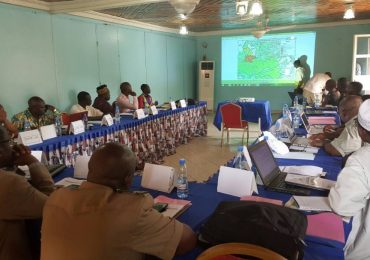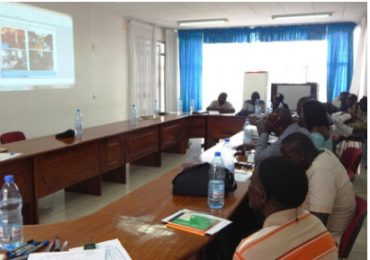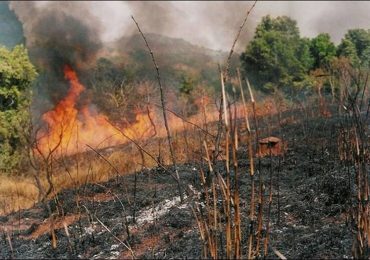Desertification can be defined as the process by which a fertile land becomes desert, typically as a result of drought, deforestation, or inappropriate agriculture. Desertification, land degradation and drought (DLDD) have accelerated during the 20th and 21st century, particularly in arid, semi-arid and dry sub-humid areas.
According to the United Nations Convention to Combat Desertification (UNCCD), the latest estimates indicate that 12 million hectares of land are transformed into new man-made deserts every year.
In Cameroon, the Far North and Adamawa Regions have been the hardest hit. A researcher and plant scientist at the University of Buea, Dr. Fonge Beatrice, says the causes of desertification in the North of Cameroon are manifold.
She said human actions such as overgrazing, monoculture and vast forest conversion have accounted for desertification.
The symptoms of desertification in the North are very clear; soil erosion caused by wind and/or water; deterioration of the physical, chemical, and biological or economic properties of soil; and long-term loss of natural vegetation and flooding.
Flooding removes the top soil. Flooding is as a result of bad water channeling which is a human factor. Most water sources have been deviated in the North either for irrigation or dam construction. When this occurs, it leads to flooding. When this happens, the water pressure becomes very high and floods the top soil. The excess water carries away the top soil that has been overgrazed and the soil becomes infertile because the nutrients are washed away
Another problem is the excess use of chemical fertilizers. Because the soil is oversaturated with these chemicals, the repercussion is growth becomes vegetative than yield. In addition, this causes pollution, because when chemical fertilizers are used on the soil, only 2% of it goes to the crop, the rest is washed down by the rains and it goes to other waterways to cause pollution.
Monoculture is another problem. Northerners have for long adopted monoculture as a farming habit for such a long time. They plant rice, corn or wheat on a particular piece of land repeatedly and as a result, these crops exhaust all the nutrients they might possibly need and the soil becomes infertile.
Dr. Fonge equally explained that the geometric increase in the population of the North has led to an increase in the demand for grazing and farm land thereby orchestrating desertification.
“The people of the North by their nature are nomadic cattle breeders. They feed their cattle year in year out on particular patches of land and this leads to land degradation. Land degradation reduces the value of soil, water, plant and animal resources to society. It also reduces the quality of ecosystem services and the levels of biodiversity in natural and transformed systems. All of these result to desertification,” Dr. Fonge explained.
The researcher also explained that one of the major problems leading to desertification is that of waste.
She said because Cameroon lacks the necessary technology to have storage facilities excess food is often wasted and in the dry season when the cattle lack what to feed on the grazers move to another field.
“This has been going on for decades. It has even worsened given the increase in population and demand for more pasture. Fertile lands keep being converted to deserts. If local preservation techniques are not used, most parts of the North could be converted to deserts,” Dr. Fonge warned.
Desertification and land degradation are considerably limiting land productivity and its ability to provide ecosystem services at local, national and regional scales.
According to UNCCD 2nd Scientific Conference 2013 Background Document, the loss of ecosystem services in the North is manifested through decreases in soil fertility, carbon sequestration capacity, wood production, groundwater recharge, grazing and hunting opportunities, and tourism – all factors that directly impact the economies touched by land degradation.
With soil nutrient loss, which includes losses of nitrogen, phosphorus, potassium, and organic matter, agricultural income is also impacted by increases in production costs resulting from the need to apply more inputs to address the negative biophysical impacts of land degradation.
Impact of Desertification
Farmer grazier conflict is a serious problem in the North. Dr. Fonge recalled that on January 1, 1981, in Wum, graziers entered a farm to graze but because the farmers refused, fighting began, and about 10 people died.
Similar clashes have been recorded over the years. Hunger is equally another problem that arises from desertification, given that when a land becomes infertile, agricultural production drops.
Desertification also has a very negative impact on the economy since it triggers natural disasters such as floods. When these occur, people die. This means a reduction in workforce. In addition to these, huge sums of money which would have otherwise been injected into the economy to create jobs are given as relief aid.
Remedies To Desertification
According to Dr. Fonge, education is the most pertinent strategy to take up to mitigate desertification.
“Education from the grassroots to policy level is vital; local farmers should be made to understand that mixed farming is slightly better than monoculture. Farmers should desist from overgrazing in a particular area given that it exposes the soil and makes it barren. Farmers and grazers should also reduce the amount of food wasted and develop local means of storage,” Fonge advised.
Factors of green vegetation should also be taken into consideration where farmers learn to plant and harvest sustainably. Research should also be done to find out the type of crops that can do well in the Northern Region rather than using chemical fertilizers to guarantee production for the crops they have been cultivating.
Dr. Fonge suggested that the government could improve on research in storage so that waste can be reduced and thus reduce the amount of pressure put on land.
She advised that Cameroon should learn from what obtains in other African countries, quoting the example of Kenya and Northern Nigeria where excess corn gotten from the farm is stored in Salloys such that when harvesting is over, they can get corn from these stored houses. This is done such that corn can be available all year round.
“In Cameroon, the South West Region is one of the highest producers of corn. What can be done is excess corn harvested is stored so that it can be used for the rainy days or given to those who do not have. There are technologies that can be used to store corn. We must not only depend on sun or “banda” to preserve our food,” Fonge said.
She equally urged farmer to shun the use of chemical fertilizers.
“A survey on all the soils in Cameroon is very important at this stage to determine what crop can go on which piece of land. In Cameroon we don’t know our soil chemistry. If we must use fertilizers, then we must understand what kind of fertilizer is suitable for which soil. This is because wrong use of fertilizer can cause a boomerang effect on the soil and instead cause more harm on the environment,” said the plant scientist observed.
She advises farmers to adopt more environmental friendly farming practices like using nitrogen fixing plants such as agro-forestry species to improve the quality of the soil.









